Slashing Steel With Mr. Sawbladehead
By Travis Failey on December 13, 2018Jordan Raiff: First and foremost, thanks for taking the time to sit down with us here at Rocket Sports and Entertainment Network Shawn. With ‘Blood, Sweat and Steel’ coming out, making new pieces of art, and drumming for Nova. Rex I know you’ve got a lot on your plate, so I really appreciate your time man.
Shawn Lowery: Oh no problem. I appreciate you.
Jordan Raiff: So first and foremost….We have got to know, when did you get your start in welding and fabrication; and who inspired you to get started in this?
Shawn Lowery: Oh, it was simple. It was my dad. I was a kid. We literally had one of those old dirt floor garages, he would get done with his shift wherever he was working at, and I would just go hang out with my dad. I kind of piddled around with little hammers and stuff like that and then watching him weld and then I piddled around for a few years, nothing big or major on it…..Oddly enough, I was actually a professional artist since I was six years old too, and then, when I got into music that changed everything. I was huge kiss fan, I took all that art and creativity and put it into like stage design saying, “Hey, if I was in kiss, you know, what will my character be, what would I build’? And it was Kinda like, “Well man, Peter Criss you know, he can’t use all the cool costumes because he’s back playing drums where these guys had platforms, all that stuff.” So I started incorporating all the things that I was thinking of. “What would I would be, how would I create for kiss?” So when I got into music and started, started to actually build in stage stuff, I tell my dad “Hey dad, this is what I may have thought of, can you make it?” And he just got tired of always doing all the work and he’s just like, “I’m going to show you how to weld so you can do all this stuff”. And that’s what, you know, he taught me and obviously he continued to work with me until I moved to Florida. I mean he, and I actually….this is back in the day when, you know, like MTV was just came out and like most people didn’t have cable. So, um, we actually, we did, we did our own ‘Rock’n Roll Rollercoaster’ which was one of my ideas that I wanted to do since I was a kid. When I went to the circus and saw the, the guys in the Globe and the spinning motorcycles.
Jordan Raiff: Yeah. Yeah. The Wheel of Death.
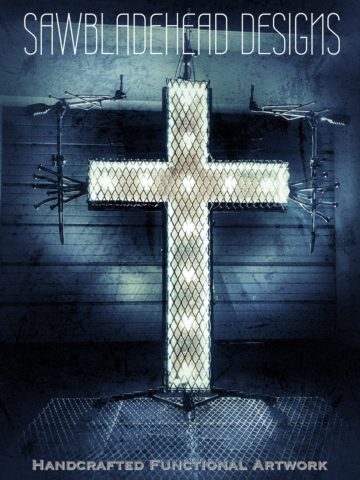
Shawn Lowery: So I, you know….I was a big Kiss fan. I thought, “Man, you know Peter Criss….” I actually came up with the drum cage designs, you know, the actual drum cage, where drums are clamped onto the cage and stuff like that. Because to me it was….I was like six or seven. It just made sense. He’s a cat, you put them into a cage. That was the thing. And then my mom took us to The Surface and I saw that. I’m like “Aww yea that was so cool!!! What if I put Peter Criss and that cage, but it spun?” And that’s how I came up with the concept. And then decades later, you know, I’ve always had these, I’ve tons of different like stages ideas that obviously we couldn’t do it because for one, we didn’t have the money. And two, you know, obviously I didn’t have the knowhow. I’ve had this idea for years and my dad actually helped me with my first two drum sculptures. And for the Rock’n Roll one, we bought an RV, cut it in half to put it on the scissor lift. Then we’re going to have another trailer where the actual kit mounted on the back and was like, it’s a giant U, kit slid in back and bolted on up,went three stories in the air spun upside down every, every which way. The platform itself was a pressurized water tank, so it sprayed water toward the crowd. Obviously we had to CO2, so it would shoot out. The top was actually a gas line….This is back in the day where hey, you can have gas. So we had gas lines in the top, so it looked like the vector, stove….gas burners, but all at the top. So it’d be a big ol’, 18 inch flame all this stuff. Then we get ready to run the hydraulics, and my Dad wasn’t skilled to do hydraulics. He wanted an actual company to do it. And my buddy was like, “Hey, you see Tommy Lee’s kit?” And we’re like, “No.”….We didn’t have cable. And so, he actually recorded on VCR, and I looked at it and I’m like, “Son of a bitch!!! We worked for two years, and spent like 10 grand on this thing!!’ And then even though ours look cooler and did more….I would love to say, you know, everyone’s going to think that I copied Tommy Lee and not realizing the amount of work and, you know, the whole backstory on it. I’m like, everyone’s gonna think I copied them. I said “I can’t use this.” We literally took a torch to it. We scrapped it, sold the RV and that’s the one thing I’d him, my dad and I both regretted as well. You should’ve just got it done and you know….We were doing festival gigs and stuff like that. We could have very easily just continue to tour around with that. And that was one of my biggest regrets is not finishing it when we were so close. Only because someone else had a similar design. But like I said he was, he was the one that, taught me everything from all the builds, and any of the skills that I had, it was because of him. Obviously the more you practice you get better at it. But even when I was in Florida and he was still back home, he would give me tips and tricks and stuff like that. So. Oh yeah. He’s in there, and my mom as well too. She wasn’t a welder, but she was always there. She always helped my brother and I both she was an art major. She would sit down with us and we would draw and play with crayons and Play Dough and all that stuff. So she was a big influence on just molding our artistic skills. So yeah, very blessed to have both of them.
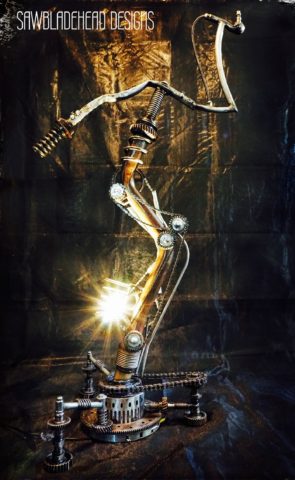
Jordan Raiff: It certainly sounds it. I mean, they definitely sound like they were a massive influence on that. Oh, that’s, that’s great to have. It’s something a lot of people lack. Now, as many people may or may not be aware that you’re not just a metal fabricator, family guy and a drummer in Nova Rex….You’re also a cancer survivor. In fact, if I remember correctly, it wasn’t too long ago…..after your first year after you went into remission that you and I actually met. It was when Queensryche, played over at the Cuban club over in Tampa. Has you know, getting cancer into remission and conquering it; how is that playing a role in how you’re living your day to day life and how you’re doing things? Have you had a huge change in between those times?
Shawn Lowery: Yeah, but matter of fact, I actually, before I was even diagnosed because I was big, you know, tons of cookies, sugar and stuff like that and ended up in one of the main reasons was because I loved it. But also when I would go out and then I would eat a little bit. Sugar would actually fill you on up. I know it made you, so you weren’t hungry and that would be good. Be able to go out and work for four or five hours, come back in to eat a little bit. So I would really only eat like when one meal a day, everything else was out there just eating crap. Same thing with the sodas and stuff like that. Then I started cutting back and certainly read the articles. It’s like, all right, I’m just going to, I need to. I need a team that’s down. And then by that time is then when we started to get checked out and everything else and then come to find out what it was. Like all right, well I definitely have to do it. It was just like, it was like you have had to stop because during, with all the testing and everything else, I mean I was down to like, like pretty much like bread…..some bread, but mostly water. I mean, you know, there’s people, like my dad had it a much worse. I’m not complaining, but as you know, as far as food wise, nothing tasted right. I mean I literally was like down to water and whatever else. No salt, no sugar, nothing for months. I’m like before all the stuff from MOFFITT and then even after that. But yeah, I’ve, you know, I’m able to eat, you know, I just have to watch my sugar intake and I definitely eat better than when I did before. And uh, you know, thank God for, my wife was always there and keeping up on things, making sure that people had everything down right. MOFFITT team was, was amazing, so you know, it just gave me more of a kick in the pants to try to do as much stuff as I can and kind of look like, like I’m trying to catch up stuff that didn’t get accomplished. I’m trying to make up for lost time so to speak.
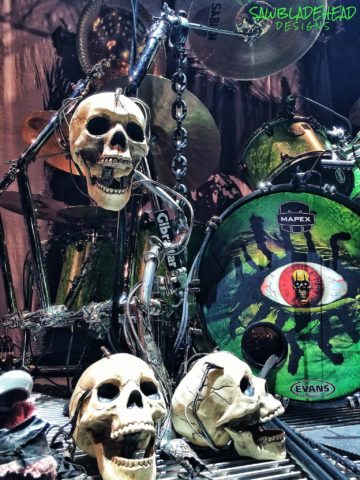
Jordan Raiff: Okay. You know that I can definitely make a lot of sense of that. I’ve seen a lot of people when they’ve gone through different versions of disease or different versions of illness, whether directly or through their family, you see a lot of change in them. So, I mean it’s definitely, it’s good to see that, you know, you’re in great health and good spirits with that, you know, definitely glad about that. You know, that also kind of makes me wonder about something else. Where did the name Sawbladehead come from? Was that something that was inspired during the cancer? Um, during everything with that? Or is that something that you’ve had a nickname as from long ago?
Shawn Lowery: It was long ago, the joke….the joke now, because I have the giant scar from neck to neck, that people that don’t know me and you know, they say, “What is this, what is that Bladehead, that nickname?” I was like, “Oh, that, I was in a really bad saw blade, accident and saw blade and just almost cut my head off.” I always kind of get people going on there. But I was like, no, it was um, I had done this now, this was back in Ohio. So I, my dad had his weld shop and I don’t know if you’re familiar with ‘Stomp’ the Broadway play.
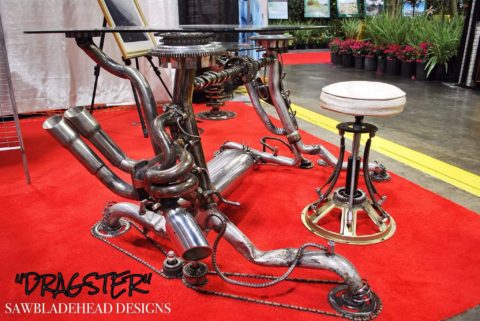
Jordan Raiff: Oh, incredible piece.
Shawn Lowery: Yeah. So I loved, I’ve always loved those guys and I’m. So I’m in the shop and you know, I’m, I’m hearing always hearing grindings and bangings and stuff like that. And I was like, “Ya know, I’m going to do my own version of that.” So I took all of these welding bottles and grinding tools and stuff like that. And I created this piece. It was recorded, this piece took my recording gear and did it. And then, um, I had, I had owned my own recording studio back in Ohio called ‘Hot Track Studios’ at the time, we were remodeling, add an iso booths and stuff like that. So it was all kind of framed out and all torn up and saw different tools and everything else lying around in the studio. So my guitar players a drive an hour down and they usually a crash it at the studio every weekend. So they’re down there and I say, “Man, why don’t you guys check this out?” So I gave him the CD of what I had done and then, uh, came back the next day, as I said, they were, you know, they was crashing out and hanging out and they came back and. I walk on in and…..they had a mannequin for whatever reason and had it all decorated everything else and like, “What the hell is this?” And they’re like, man, “We’re listening to you. Listen to that, you know, the track you recorded….” And um, we had a basement in Ohio in the studio, real dungy type of basement and everything else. And they’re like, “Yeah, we were just sitting around drinking and thinking of that thing and just imagining you making this thing it.” And then they just started thinking of this, you know, alter ego type of mad scientist type of create a creation that I’m down in the basement. And, and I looked up and I’m like, what the hell is that? It was a mannequin. And then at the top of his head didn’t have a head. They had a sawblade on that and I just draw a smiley face on it. And they said, “Yeah. So we just was thinking about you in this, in the basement is this mad scientist. And uh, so we created that for you.” I asked them, “What the hell is that? It’s it says Mr Sawbladehead” and laughed on that and, I think I named the track, you know, like, uh, like ‘Music from Mr Sawbladehead’ or something like that. I never did, really didn’t use anything from it. I just kinda labeled it that track until I moved to Florida and I was like, okay, I’m gonna give, you know, getting back in the music and stuff like that. And it’s like, I gotta think of something kind of cool to, you know, who’s going to remember, you know, remember me after they meet you or something like that. And I’m like, you know, Shawn’s……they’ll forget that easy. And I said, “I’m gonna use Mr Sawbladehead because, for one, if I say that I know the first thing is they go, ‘What?'”
Shawn Lowery: They instantly say, “What the hell is that, Sawblade?” And I was like, yeah, even if they don’t get the whole Sawbladehead will get that, they saw blade dude, guy, whatever. And it, and I just used it and it started, it started to pick up. People, started to remember, “Aww I saw your, you’re that Sawblade guy”, whatever. And it started to take off. And um, as far as then it started rolling, rolling into, all the fabricating stuff and the fabricating stuff once again was….I didn’t, I wasn’t planning on welding when I came on down here. Matter of fact, all my welding stuff was at, was in Ohio. My Dad was like, “Take the small little Lincoln welder.” Because I had had a big Miller at the time because like, “Take the small one, you never know when you want to weld something this way you could, you’ll have something to work on.” I literally had that welder for like four years and never even used it in here in Florida. I was always working and playing in bands and stuff like that. Then I just got the urge that I want to, I want to build something for myself. And started doing the Life Tree or doing some bike stands for people……..I did some little furniture pieces but nothing like artistic. It was just kind of, you know, basic, you know, basic stuff. And then started doing this or doing that. People started taking notice. And then when I got into bands and started traveling and stuff like that, then I was like, yeah, “I’m going to do, I’m going to do one of my creations!!” Which was the Life Tree. And I’m like, “How in the hell am I going to do this???” Because for one, how I wanted to accomplish it, I needed to forge, I needed or I needed an Oxy-Setaline tanks to heat up the metal to actually mold it so I can hammer it, didn’t have any of that, couldn’t afford it, and didn’t have a place to store it and everything else. So I’m thinking, “How in the hell am I going to do this???” And it was always in the back of my mind because I had that concept when I was six. So I literally was just like, just experimented. I had a chop saw my little grinding, sanding tool and made my own fab table. I Started making some cuts and then just started literally hammering on steel; steel on steel and sai to myself “All right, well that looks kind of cool.” And did some more, welded on it and hammered it again…..So that’s what I did with, with the, the cages. I literally just took everything with all manual cuts and we made a fab table, put it in there and use a pry bar and just hammered all that shit together.
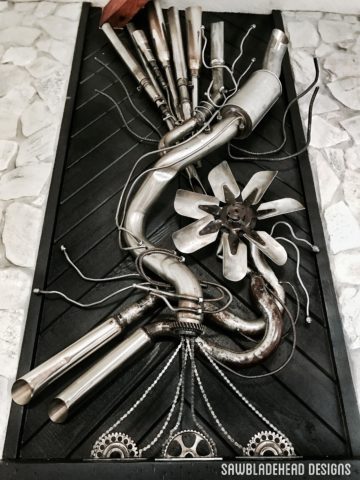
Jordan Raiff: And I’ve, and I’ve seen Life Tree before sat behind and taken pictures with it and just, it’s an incredible work of art and the fact that that’s made that way and not through Oxy-Setaline and not through all that, that really is an extra credit to your ingenuity and your ability to fabricate. And it’d be able to make from, you know, from separate parts to be able to make something a massively cohesive with the lack of resources there. It really does speak to us; true creativity and you as a person. Now that being said, is Life Tree your favorite piece to date, or do you have another one that really just takes that top tier of like what, what hits your heart for the, your favorite piece you’ve made for yourself? You’ve made period.
Shawn Lowery: Trying to think of some of the things. Um, it’s definitely Life Tree because it has more of a story than anything. Just because going back to Ohio where I was creating stuff, then it’s just really kind of before the internet or maybe because I just, we didn’t have cable and stuff like that. Maybe the Internet was around. Anyways, but I remember drawing, doing some of my, drum sculpture builds and stuff like that. Then I started seeing similar people come out with like, you know, Tommy, Tommy Aldridge had a similar drum kit and cage to mine and, and there was another couple of other companies that kind of came out with similar, similar designs, you know, later that I found out because I said that wasn’t familiar with these companies or anything. And then um, but the Life Tree, you know, I came up with that when I was six at six or seven when I saw the ‘Destroyer’ album again doing stage designs and I saw destroyer album, so all the ya know, apoctoliptic, you know, the destruction, the background, and the second. Okay. Once again I was big Peter Criss fan because I always wanted a power him more because, you know, Ace Paul and Gene were all up front. They got all that stuff. It’s like, what can I do to make him, you know, really stand out; more than just the riser? And I thought okay, well that tree looks really cool and I was always inspired. My Dad had done this brass, a little brass tree and I just, I just was always just like literally fascinated by it. And what it is is that he had done, he had molten brass and you just come do it, like drop at a time. And he literally made this, this tree and I was always just intrigued by it. And for whatever reason, just as one of those things that. And maybe that’s, that’s probably what inspired me and I just absolutely loved that thing that got the destroyer album and saw that, like, yeah, almost like a tree. I can kind of, you know, I can kind of see that this was even after the rollercoaster concept. So then fast forward we’ll come back to here in Florida and I like, all right, well I don’t want to announce that this, it seems like whatever I make someone comes out with something similar to it. So I didn’t, I didn’t tell anybody about it. Literally started doing, uh, you know, the cage portion and I the night when I got the cage, don’t get that done in like three months. And then I’ll use that for literally like five years, five, seven years, something like that. And um, and uh, but that wasn’t the full design. The full design was the life tree the entire and reason I didn’t do the base was because we were traveling and doing gigs that there was already rises there or the ceilings were low and I bounced, sticks and stuff like that. So was, it was pointless. It was like, all right, well I said now that I had the band wasn’t doing anything, it’s, ‘Oh, I got, you know, three, four months. I should be able to do that base…’ 10 months later…the base, because it’s, you know, for one, you know, not the same, same resources that I had, you know, I had no, no Oxy-Setaline, you know, forging. Um, I did finally get a manual hydraulic pipe bender, but still I was still handling everything myself. Literally did it on a two by four slab of concrete on Dina’s backyard before we got married. It was all grass and had one little spot. So that’s where I did everything and I would literally kind of like look at it and I would carve like little lines and the dirt and then that’s where I kind of see the branches flow out and stuff like that. So I had to work and once again reverse all, everything was free formed and I’m the only regret that I have on the Life Tree. I wish you would have made it four feet tall. The reason why I did it three feet is because I’m real flexible and I thought, all right, well I can, I can get my leg up three feet and jump up. Didn’t think about a step or anything that’s just shows you how smart I was. So I did it three feet and then laid just that one piece of pipe had been another kind of looked at it, looked around, did a third, fourth and did all that and then literally you’ll see I have pictures on my FaceBook page of it. Just you look at it, it’s like, what the hell is that going to be? It’s like you look at the two, two pieces of steel that I just bent and then you look at the Life Tree, and it’s like “How in the hell did you even come up with that???” So having a concept when I was six and always literally having that, it’s like, okay, that’s the reason why I kept it secret and it was always something that. It’s definitely a, it’s a, it’s a spiritual piece for me because there was times when I was doing the actual base, the actual cage part that, you know, I know I got heat stroke and not even now…..I don’t even remember even doing, doing things to be that after a day’s worth of work and things will be done. Don’t even remember even doing it. Yeah, it definitely is. But to me it was a definitely a gift from God because like I said, I knew, you know, back when I was six and I want to do something incredible that was going to be, you know, kind of like a legacy piece and um, and I feel that the Life Tree actually is and now when I get done and I see it as like, “Oh man, I can do that so much better right now.” Because when I did Ray’s China stand, like I said, how that incorporated into that kind of wraps around his China is what I wanted to do for the life tree. But I didn’t know how to do that. So I didn’t have the techniques and skills, now that I have better technique and everything else, it’s still don’t have a forger or Oxy-Setaline tank…..I definitely on my bucket list of stuff I want to d…. I want to do another and a bigger Life Tree and I want to be able to do the illusions that I actually have in it. So that in the long story, uh, that’s probably the most, it’s one of my favorite. It also has the most profoundness to it just because of the story that it has behind it from coming up with him from six, and then decades later, doing it….not even knowing HOW to do it, you know. And I said it was…it was definitely, you know…God was there to help me build that thing. It’s such a profound image and design. Even till this day I get a little bored by it because it’s, you know, it’s like, “Okay, I did it.” I wanted to go onto the next thing; but when people see it…especially when it person….as I’ve said before, the pictures are great, but when they see it in person that has a life of its own.
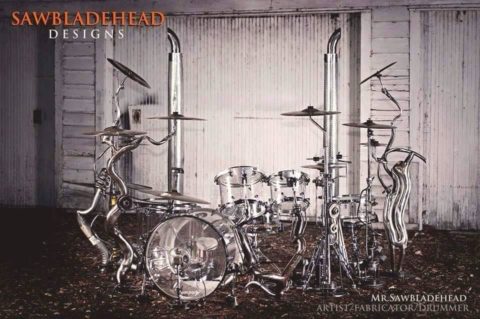
Jordan Raiff: No, I agree wholeheartedly. I’d seen pictures of it before I went up to see it at Sam Ash and when I saw it in person it just took on a whole other life of its own. And I’ve been there a few times since. While, it’s been on display there and every time I look at it I ended up finding something a little different. I find little, little, as you mentioned, you know, little nicks differences in the belt, and bends everything else. And it’s just, it’s really amazing to see that in, as you mentioned, that hand quality is really evident there. It really is. Now you mentioned a lot about Peter Criss and you mentioned a couple of other drummers in there, seeing as how making custom drums sculptures and things like that. It seems to be one of your biggest specialties, although we know you do a bunch of other things. Like your custom tables, furniture, guitar stands. So on and so forth, are there any artists that you’ve been Jonesing to do something for the, you haven’t had an opportunity to that you’re hoping that ‘Blood, Sweat and Steel’ will offer you that opportunity to be able to go ahead and do some work for?
Shawn Lowery: Oh yeah. And it comes, it comes down to it. It’s a, it’s a money thing. Money first, money first and then time. However, with this whole show and how long I’ve been working on it and everything else. You know, obviously Ray Luzier is a, him and I been talking for years about, about that and I specifically wanted to wait to the show’s up and running and I get the sponsorships that I needed just because he’s such a, you know, a iconic drummer that I need to have. I need to be able to do that correctly. And I definitely wanted to have a funds in order to do that. Glen Silva was another one because I actually did a whole, um, I did sculpture work for Alice Cooper on different couple of different tours…I did the last tour with Motley Crue. And I’m on there on the Crue’s farewell tour and um, I had given, I’d done this whole stage design and then they had actually given it to Alice. Alice loved it and now we’re….Once again, it’s just timing. It’s a timing thing where I said, ‘Hey man, it’s like, you know, I’ll tell you what, you pay for materials, I’ll do everything and I can get it done and blah, blah blah. When I see you in Tampa, I can give the studio stuff to you. So you won’t have to pay all that money on freight. And um, it just, it was a timing thing. It just didn’t get a chance to work things out. It’s not out of the woods as far as working with them. Hopefully in 2019, whether it’s a whole stage design, but if not at whole sculpture work that I had for, for Glenn, that it fit and I absolutely loved it and everything else. So Will Hunt, him and I’ve been talking for years. It’s just with him a scheduling thing as well too, because he’s always overseas. He’s only in, in Orlando, so it’s….that’s the one that we can actually do because it’s realistic, because he’s in town, um, I don’t know. There’s a bunch of other other artists, mic stands and stuff like that. I liked the drummers because that’s just a cool thing because it’s, you know, even if you don’t have much of a stage design, if you got a drum kit with a cool sculpture, I mean they pretty that is your centerpiece. And like I said I don’t know how, how you feel about it, but it’s like….
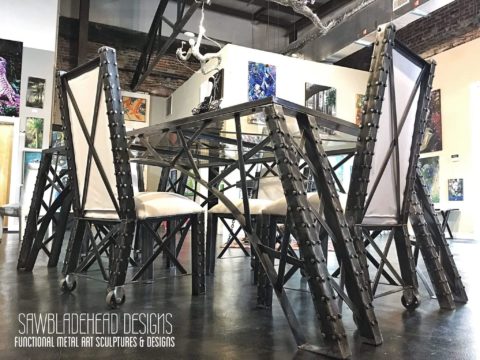
Jordan Raiff: To be honest with you, working so much on concerts, I always try and get that perfect drum shot. One of the biggest annoyances for me is the way some of the cymbals hang. It’s like just in the middle of this perfect face shot. And I’ve noticed when looking at a lot of your sculpture design, whether intentional or not, it almost seems as if there’s a thought for the photographers to be able to get in and get that good drum shot. Whether they be playing on an eight inch platform where they’re playing on a four foot platform, it’s designed, at least from my perspectives to have that in mind. And that’s really amazing to see. And as you mentioned with the other two, three, four, five, however many people playing in front, they already have their ability to have tips and tricks, you know, show off for the crowd. The drummers kind of, they’re confined to their area. So having that really gives them something added to special in, you know, and you bring a perfect touch to it. Honestly.
Shawn Lowery: No, I don’t think of it as far as a, you know, in your sense, but I look at it as art, functional artwork because there’s actually a, you know, the way that they positioned their, you know, their, their symbols and drums and so forth. There’s a way they do it. It’s the whole typical, you know, tongue in cheek, if it’s, you know, they say fengshui. There is, there is a. yeah, I see that. It’s like I see what people in they get the things are crossed over and ‘Which way is it? Why is it that just looks like shit, why you, why did you cross it over this way you could have done….’ And um, even with the straight bar, um, but, and then that was back in the day when, whenever I would go to a, you know, when I was a kid going to a concert and I would see, you know, it was always a big thing like, hey, what, what’s Eric Carr’s, you know, new kit going to be, is it going to be chrome? Is it gonna, you know, that was always the big, the big reveal type of thing when you go see it as like, oh, I always loved that because that’s what you want. You want that, that holy shit moment when you go see a concert, you go see a rock band. And um, that’s how I always fell about the drum kits and stuff like that. As you know, I want to see that and I want to, I want to see that, you know, that holy shit moment when I just go in there and there’s not even a person onstage, you know, you just look at the staging you’d like that just takes your eye. So that’s, you know, that’s one, one way I’ve come up with the sculpture work plus the fit within the style of the band and you know, whatever types of music they played and also the way that the drummer of moves and flows and stuff like that. Um, as you saw with Lotus, you know, Casey decided…..He’s never had the eight inch tom way up there. And then when you do, when you see it with him, the stands and this thing up there, it looks so out of place. It’s like, “What the hell is that thing??? What doing way over there?” And it’s got all this empty space and everything else and negative space. That’s the reason why it’s like I had to have some fluidity because, you know, when you see Casey perform…he’s a performance monster, and I just had to create the movement within the artist as well as the, what I envisioned art wise and sculpture wise for the kit and combine all that stuff. And so that’s, whatever we can agree on.
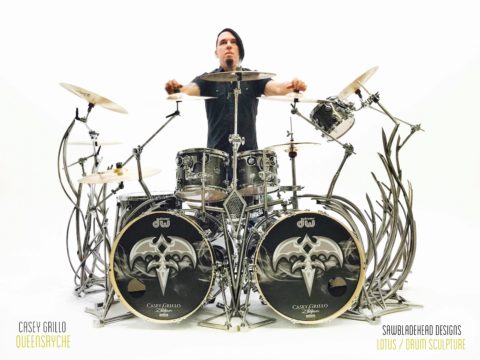
Jordan Raiff: Lotus is….speaking to that one again, it’s definitely a very intense sculpture, it really is. The way that you’ve got it set up so that it’s two separate pieces, not just for transport, but also the fact that it gives them the ability to more or less open up Lotus as more…that’s right three piece. Yeah, that’s right. That’s right. You’ve got the centerpiece. That’s right. Then the incorporation also with Casey, having the first ever with Drum Workshop, the first ever LED bass drum cover….When I went and saw the kit set up without it. It was beautiful, but that was just, you know, no sugar, pun intended here, but the icing on the cake right there with that.
Shawn Lowery: And that’s another, that’s a, it’s an, it’s an echo, another almost like fate thing. Because I’ve known Casey in Kamelot for years and literally I think Rollie for about four or five years. Thomas is Kinda like, man, we want you to do a keyboard stand. I’m like, yeah, whatever you want to do. I mentioned…..I met him back in the old Bourbon Street, you know, the OLD Bourbon Street. And uh, same thing. It’s just like, dude, you got my number and once these guys who got my number contact me. And it was always a timing thing…, ‘Oh, we’re, we’re getting to go out on tour in three weeks, well maybe we should have contacted me two months ago……Never worked out. And then Casey was like, well, I want to do this and this and this and cool. And then once, once again as things. And he’s told me about things that he’s been working on and I actually kind of saw a prototype of the LED kit of the LED lights and stuff like that. Um, but it wasn’t working like how it was. And so years, progressed and everything else. And um, and I started getting the show together. And then, like I said, I knew that Kamelot because the timing worked out well and I’m, so I was talking with Thomas about building some stuff for him and I’m like, all right, great, go ahead and do your mic stands and I’m gonna do this thing for Casey. And um, and it was like, “Hey, just to let you know…..” And then that’s when I found out about everything. And then he told me that he was going with Queensryche. And I thought, well, it’s kind of good for me because now I can do Kamelot and they could do Queensryche. So, and that just worked out perfectly too because when I, Scorpions came around, I bought my tickets and didn’t even, they didn’t say anything about an opening act and I got my receipt and thank you for your ticket. Special guests, Queensryche. I’m like, “Wow!!!” And then you know, just had to get that done and you know, the time we had everything was……I had plenty enough time to do it……So down to the last point, I had had 11 days to build that thing.
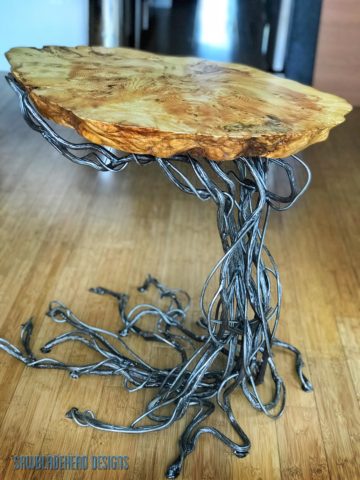
Jordan Raiff: Not to say it showed, but it showed on your face when I saw you that day. You look like you’ve been off work in 23 hours a day for the last 11 days…..
Shawn Lowery: 16 hour days, and sometimes longer depending on what day it was. True.
Jordan Raiff: Now I know that while we were there doing the photo shoot for the unveil and everything and doing some behind the scenes stuff. I know that that was part of the web series for ‘Blood, Sweat and Steel’, what made you decide to do such a unique web series and what can the people who tune in expect to see on their end? Is this just a showing off what Shawn does and that’s it? Or are they getting more behind the scenes also into you as a person as well? What do they, what should they come in with an expectation of getting?
Shawn Lowery: It’s actually…..the show itself wasn’t even my idea. I’ll try and give you the long story. You can edit it down if you want to….
Jordan Raiff: Go whichever way you want. Man.
Shawn Lowery: When I finally…to give you an example. When I had the Life Tree done, I tried for literally three years and I, I hit up every single drum company to have my Life Tree at NAMM and every single one turned me down and he said, “It’s like, man, this is, you know, great job, blah, blah blah, but this is going to take away from our drum kit.” And I’m telling them, “No, it’s not……It’s an amazing piece and people are going to be floored by, they’re going to come up to it and everything else. But they’re eventually gonna be focusing on your product and that’s how you’re going to get people there.” And I said, “So if I want to go to these other guitar companies and they see all the hot chicks there with the guitars and stuff, I buy the guitar, do I get the girl???” I mean, come on, you’re concept isn’t working out. It doesn’t. So three years. And finally this is when Crush was taking off. And they were after three years they were, they were up on the plateau. And um, it was just perfect time. And I met up with them and presented it to them and they going, yeah, we would know about your stuff and say. And they were like, that’s no brainer, because at that time it was the perfect time. They, because they wanted to have something that would put them over the top. And uh, and I told him, I said, dude, you guys have no idea what’s going to happen when this thing gets there. And um, I said “It’s not going to be huge. It’s going to be on another level!!!” And it was. So at NAMM it was here’s, the people….It was the talk of NAMM. It was one of of the biggest things from NAMM. In I guess decades according to hundreds ofpeople that have told me that and up comes everybody, “What’s the story? Tell them the story.” Another older gentleman came on up and said the same thing. “What’s the story?” I gave him the story. He’s like, “Well, I’m so and so from the Discovery Channel, these, my associates, blah, blah, blah. That would make a great show.” “Oh, cool.” Didn’t think anything of it. “I got your card, we’re going to be talking.” And that happened a couple of times at NAMM, you know, this is “Well I’m so and so from some production company.” So that got me, it got me thinking and I have, my little brother is in LA, he’s actually in music and television and I’m kind of telling them about that and he’s always told me for years to do a do like a, a YouTube series of, you know, do it yourselfer type things they have, and it’s like I’m not, I’m not that. To me, I’m not that skilled guy. You know, when I think of skilled, really like the skilled labor guys, I’m thinking of the guys that build the cars, that know all the mechanical aspects of everything. And I said, you know, when I go to do my steam punk stuff, I mean I don’t…..Now I know some of the parts, but when I was doing all that steam punk stuff and the Gear Head, I couldn’t tell you what a fly wheel was versus a brake rotor. No clue. Because even when I go out to, you know, the scrap yards and stuff like that, I literally find something that just intrigued my eye. Um, but, uh, where am I good? Where we’re going for the question. I guess it’s okay. (Laughs loudly)
Jordan Raiff: We were talking about, what made you decide to do such a unique web series? You know, everything were talking about the discovery of people.
Shawn Lowery: So I’m sorry. Yeah, yeah. So the web series came about throughout the years of mold, molding into kind of the idea. And I said, “I don’t want, I can’t do be that do it yourself or type of guy because I’m not. To me, I’m not that skilled. I’m not a mechanic. I’m not like the guy that did the body work, but I have, my own unique niche that I’ve worked with these rock stars.” And then I started doing all of the furniture well because it pays the bills, but I’m doing all this really weird, you know, cool. You know, out of the ordinary type of furniture. And the thing is, is I do modern contemporary. I do little hand sculpting, sculpting of gearheads, steam punk. I do all the different styles. I just don’t have one style. And um, and I thought it then it started to shape up, you know, with, you know, American pickers, you know, Counts Custom, like the all stuff from the Velocity channel of HDTV I started to see. And then started seeing all these hit shows…..I can, I can literally be like a walk on guest, anyone of these types of shows because the stuff that I do and old school MTV when it was actually a music video and then, you know, MTV cribs. So as we’re molding the show, my mom, my little brother Chris McClure, was really saying, “Okay, we got to go in this direction, we’ve got to do this, we gotta do this.” And we had, he had actually pitched it to a couple of his reality show producers and they’re like “Dude this guy’s onto something.” Not knowing the industry and everything else, I’m always the type of guy that I’m going to do something not knowing that when I started saying, well, I’m gonna do a commercial and a pilot, and they’re like, “Oh, if you’re going to do a pilot will then send it to us.” Because they know I didn’t realize the amount of money they cost to do and shoot a pilot. And we’re talking 100 grand minimum. Um, so they were like, “Hey, well this guy is going to shoot the pilot.” It’s like, “We love the concept. And obviously we know that that guy can build some stuff. He’s got a unique niche, but if it goes with every genre, so we want to see it.” So let me….now I’ll give you kind of the short scenario…..So ‘Blood, Sweat and Steel’ is now is basically, it’ll give a little bit on me. I try not to focus on me. It’s more like I’m kinda like the host where the artwork takes over and the creative process takes over and it molds when with the actual artists, that client that I’m working with, whether it’s a rockstar, whether it’s the guy from NASCAR or it could be, you know, Joe and Susie from down the street that I had been building up a dining room table for. There’s a story, and the thing is, it’s all about the connection. It’s about the connection and the creative process for the piece for the client. And with the band stuff, it’s always going to be, you know, the bands doing a new album, new tour, they’ll give you the creative cool process of not only what I do in the fab shop but also that kind of like the, you know, the, the conflict between me getting this done in time and the bands in the studio. You know, writing, recording and they get it or they’re prepping for, you know, they’re, they’re building their stage production and stuff like that. They got to get stuff made to get there. We go on the tour so he got the conflict between, you know, what I need to do on my end versus what they need to do on their end. So you get both perspectives until the climatic moment where they get to see the piece and ‘Oh my God’, that big wow moment and the big wow moment is once again is for when you see it on stage and the crowd gets to go, “Holy Shit, this is cool.” But that’s the cool thing about it. It’s even with the rockstars it’s “Hey man. You know, building my sixth house…..I want you to do a dining room table for me.” So it has that cool aspect because now you know, not just gonna be doing a table for, you know, Steven Tyler, or whomever. Now we can incorporate, you know, Kinda like, okay, you saw the saw their celebrity status, the rockstar status, now you kind of get to see him at home.
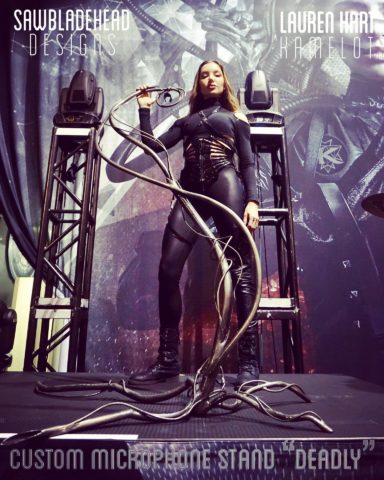
Jordan Raiff: So you get to see that take, take back to see him a little bit more down to earth and a little bit more person to person?
Shawn Lowery: Yeah. So it’s, it’s, it’s got a really wide variety with the show. And then the other cool thing about the show is that I’m big on, my dad was always big on the whole skill trades industry and as you noticed throughout the years and generations, it’s, it’s gone. I shouldn’t say generation. A lot of years it’s really….the skilled trades have gone downhill. He was always big on it. I want to help bring that back. And the cool thing about the show is it stems out to all these different avenues is that, um, the show itself, once it starts picking on up, I wanted to do these skilled trades tour. I want to go to like Home Depot, Lowe’s, Menard’s and set up basically like a skilled trades festival for whatever city we’re in, these skilled trades companies that are in those regions come there. And obviously they say, hey, um, this is, you know, such and such welding companies, you know, school. So we’re doing, we’re doing skilled trades, like basically got festival during the daytime, I’ll have my Life Tree or whatever I’m going to have, there’s different designs. And then in the evening we’re going to have the concert showcasing whether it’s a one of my acts that are on tour, my stage production. So it’s, once again, it shows people from, okay, this is the stuff you can do with skill trades. And it’s not just the structural stuff….some people think “Well I’m just going to do structural work. It’s kind of boring, whatever.” But you also had the super cool, exciting stuff. So there’s a variance of people that, well, I’m not artistic, I’m, you know, I’m very, I’m very mechanical, you know, there’s a wide range of a skilled trades that people can get into, you know, from, you know, the, the, you know, doing railings for UN security gates, to doing structural work, to sky rises to. Well I don’t, I’m not a pipe fitter, but my dad was. I Hated doing it and my dad wanted me to take the test and the whole five g tests and stuff. I just had this, like I was going to take it for him, but it’s just like I don’t want to do that. I was artistic, you know, I, I just, I would see stuff and have adhd. Oh Wow, what’s this cool shiny thing? And uh, but I want to show people that the art side you can do to it, of welding. So there’s a huge variance of, of, you know, skilled trades that people just don’t realize. ‘Oh Wow. I didn’t know that. I didn’t know that. I didn’t know that.’ And now the show goes on the road and we take it basically throughout the United States…..Now it brings it back to the whole record company thing. Well, obviously the record company and the money, you don’t, they’re not paying for bands at all. Now there’s, this gives me the opportunity to…..I can actually mold and shape, know some upcoming bands…..build stage productions and stuff for them. They literally take them on a road where people who’ve never heard them or seen them before, it can literally take them on the road with me. So once again I said, yeah, I mean it’s just the, the avenues that this thing branches out to is, uh, is just…it’s enormous. And everybody that I’ve given them the whole detail on it have just been, you know, they love it. They love it from the very beginning to the very ending of what I have a concept of it. So, you know. It’s a win-win for everybody that wants to sing starts taking off.
Jordan Raiff: No, definitely it is. With talking about companies, you know, being able to provide product, we also know that companies need to stand behind their product. As far as welding equipment. And who do you stand behind? Who do you trust when it comes to making things for Sawbladehead?
Shawn Lowery: Well, I have minimum gear, so because luckily, like I said my dad taught me that, you know, back in the day he was always….everything was American made. I grew up with Miller welders. However, all my Miller gear was back in Ohio and what I’ve literally, literally everything that I built here in Florida, everything from Mr Sawbladehead Designs, has been with my little Miller 125; a Mig welder. Literally everything and uh, you know, grinding wheels and you just change the blades for cut offs and stuff like that. I had Dewalts and Ryobi. But mainly……I’m like, an old Milwaukee cutoff a chop saw. That’s what I had with the Life Tree. And realistically that’s it. You know, I have a plasma cutter now, but I mean I use it few and far between, but like literally everything that I use is, you know, my, my Lincoln and you know, like my grinding wheel.
Jordan Raiff: I’m just surprised you only use a 125. I figured you were having a bigger battery out there….
Shawn Lowery: I have 220 out there but I don’t….I just sold the Miller from that my dad had and it just, I don’t know, just from what I’m doing…..I eventually would like to get some sponsorships I’m sure they’re going to want to get me with a better product so they can check it on out. But just, you know, it works and it does what I needed to do and I’m, I’m limited on space and everything as you’ve seen out there. So it’s like, you know, the one thing I want to buy as the forge and that’s the one thing I really want to want to get. So I have to be careful on what I buy just because it’s takes up some space naturally.
Jordan Raiff: I mean, space is at a premium, especially here in Florida. Now with space being at a premium, what’s next for Sawbladehead as far as projects? What’s coming out next?
Shawn Lowery: Oh, I’m going to have client projects. I’ve done stuff for the Dali museum in St Petersburg, client projects, which is furniture stuff. Usually, the client projects I try to film for upcoming little mini episodes and stuff like that. Some are actually full blown episodes, so it’s just keep on with the building of the products, filming for the show. As far as the actual artist, I do have….there’s Gabriel Guardian. You’ve probably seen him on YouTube. He’s goes viral the time. This is virtuoso keyboard player. I’ve known him. I had actually met, met him and his band Immortal Guardian, uh, back in 2014 and we’ve been, once again, that whole thing about trying to build stuff for them and just never seemed to line up. And I, I wish I would have…..I’m doing a keyboard stand for Gabriel. This guy is just literally insane. Um, so he’s the, he’s the next. He’s actually going to be the third, uh, the third episode. Rickey Medlocke from Skynrd. Wanted me to do mike stand for the Skynrd tour. They’re gonna be on tour for the next couple of years. Um, I sent him designs and everything. It’s just a matter of sitting down with them, confirm what he wants. You know, there’s gonna be stuff with Korn, stuff with Alice Cooper, Will Hunt with Evanescence and there’s a whole other list of, A-list rock stars. There’s also gonna be getting into monster truck. I’ve had some friends that are in monster truck so even bigger than that. Hopefully merged on over into NASCAR where I’m taking parts of their smashed vehicles and we’re going to do is to build some stuff and donated for charity.
Jordan Raiff: It sounds like a great way to do that. Ties in really a lot with a lot of what you, and I know your wife Dina does a lot of art work with charities as well as I know you do, so it really ties everything together…gets your family together all at once. Now. Speaking of bands and everything like that, what’s coming up next for Nova Rex? You guys going on a bigger tour? You got, new album coming out?
Shawn Lowery: I’ve been working on some, a new material that just basically…Kenny’s been working with different contracts, different agents on this ‘Hair Metal Mayhem Tour’. So I know it’s been in the works, so we’re gonna be hitting the road in 2019. We’re working on newer material as well. And then, I want to make Nova Rex part of an up and upcoming episode as well too; depending on when the contracts come in and the tour starts and stuff like that. So I want to do a Nova Rex build so we can have it, the stage designs and stuff like that so that there can be a part of an episode. I’m working on right now between the clients and everything else. I want to launch the release party for ‘Blood, Sweat and Steel in January 27th is the date that I wanted to actually launch everything and have the big release party and then show everybody by the episode and stuff like that. So. And then, Queensryche is the second, Gabriel is the third and so on is as things start to pick up.
Jordan Raiff: Nice. It sounds like you definitely got a full plate coming up here and going into 2019 too.
Shawn Lowery: Oh yeah. Everything.
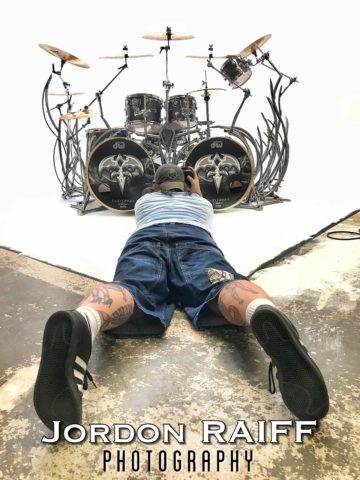
Jordan Raiff: So. All right. Well thank you very much. Shawn, anything else that you want people to know about as far as the episodes as far as the Webinar or anything like that?
Shawn Lowery: Just, uh, yeah, I mean, um, I have, uh, I’ve been doing a monthly giveaways. You just got to go to the Sawbladehead Designs on YouTube and just subscribe, I do monthly giveaways to just pick a random winner. The prize is anywhere from obviously my prize packages, t shirts and cool merge; to a autograph, you know, symbols from Queensryche, and stuff like that. So I have plenty of a celebrity and Rockstar, you know, merch that I’ve been collecting throughout the years from, you know, from Five Finger Death Punch, Halestorm and everybody else…I got all these now….and I’m going to be giving some of that stuff away at the release party itself to.
Jordan Raiff: Outstanding…..We’re looking forward to it. Thanks again Shawn.
Shawn Lowery: Appreciate it.
Tags: alice Cooper, Five Finger Death Punch, Hair Metal Mayhem Tour, halestorm, NASCAR, Nova Rex, Sawbladehead Designs, Shawn Lowery, Will Hunt





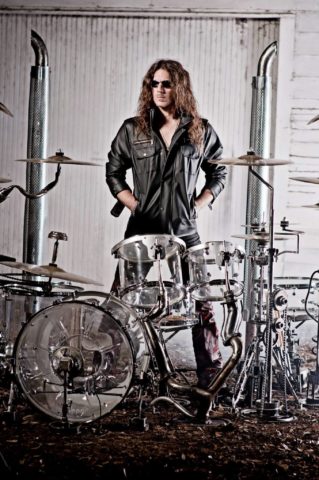
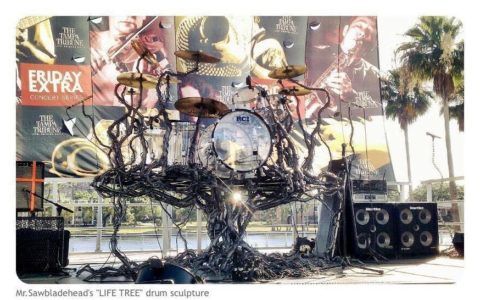
 Tweet This
Tweet This Share on Facebook
Share on Facebook Digg This
Digg This Bookmark
Bookmark Stumble
Stumble





0 Comments
You can be the first one to leave a comment.